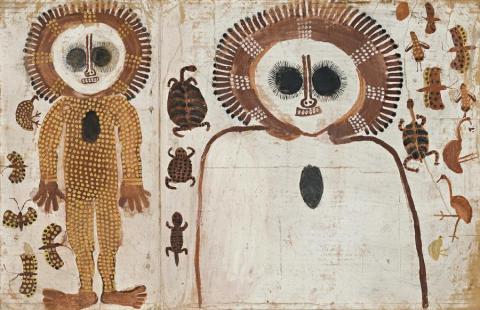A PAIR OF WANJINA, c.1970
Charlie Numbulmoore
natural earth pigments on cardboard
59.0 x 91.0 cm
Collected by Tom McCourt at Gibb River Station in the West Kimberley in 1970
Thence by descent
Private collection, South Australia
Charlie Numbulmoore was one of the few early Kimberley painters of Wanjina figures whose work is reasonably identifiable. The anthropologist Ian Crawford worked with Numbulmoore in the 1960s, when he photographed the artist repainting one of the Wanjina figures at Mamadai shelter in the central Kimberley. Crawford also collected a number of Numbulmoore's Wanjina painted on lengths of brown paper and on board. Other works by Numbulmoore, collected by Helen Groger-Wurm in 1970, are held in the collection of the National Museum of Australia, Canberra. Several of these paintings were exhibited in 1993 as part of Images of Power, at the National Gallery of Victoria, Melbourne.
South Australian grazier Tom McCourt visited the Kimberley in 1971 and made collections of art and artefacts at Gibb River and at Kurunjie Stations. While at Gibb River he had the opportunity to watch Numbulmoore, whom he called Charlie Numbulbor, paint a number of Wanjina figures. McCourt also collected a number of other Wanjina that Numbulmoore had painted on plywood, stone and cardboard. A brief description of the artist from this time can be found in McCourt's book Aboriginal Artefacts. Numbulmoore was unusual amongst the painters of Wanjina as many of his paintings include a rectangular mouth set with two rows of teeth. Both Wanjina figures in this work are shown with their mouths carefully painted. The smaller, full-length figure is shown with its body covered with careful stippling, an infill that usually represents falling rain. The lines of parallel stippling on the ochred arc surrounding the head is often said to represent óndolon - rain clouds. Wanjina beings are intimately associated with rain, water and the renewing of the season cycle by the creation of the 'Wet Season' storms. The original Wanjina paintings were considered however, not to be done by humans, but painted by the Wanjina themselves, or left when the Wanjina sank into the landscape. Historically, Wanjina painted in caves were repainted or 'refreshed' by senior custodians prior to the monsoonal rainy season.
Reinforcing the association of water and Wanjina are the secondary icons placed around the figures in the paintings. Freshwater turtles, reptiles, and other insects are all closely connected with, and special to, the Wanjina. Similarly the brolgas have close associations with water and also are a major totemic species for one of the moieties that culturally divide central and northern Kimberley.
This work, which has impeccable provenance, is an important painting by one of the few known Wanjina cave painters. Numbulmoore's paintings are held in the collections of the National Gallery of Victoria, Melbourne, the Museum of Western Australia, Perth and the National Museum of Australia, Canberra.
KIM AKERMAN
